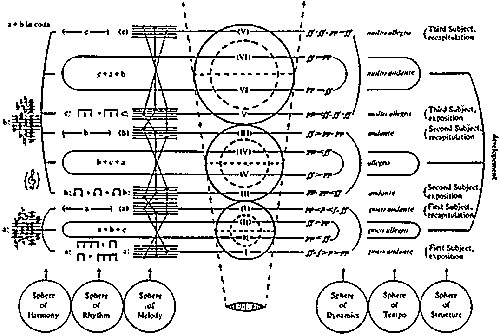picc.2.2.2.bcl.2.dbn-1.1.1.1-perc(3):12unpitched membrane drums of 4 different sizes-pft-strings
SINFONIA DI SFERE - Symphony of Spheres - my fifth symphony - is an abstract work, a musical structure influenced by the beauty and mystery of geometry. The title has no connection with the philosophy of Pythagoras ("music of the spheres"), nor with astrology (unlike the planets which inspired Gustav Holst).
In this work, the concept of spheres gave me a double impetus: first and most essential, spheres of contemplative thoughts and emotions; and the secondary aspect, a group of spheres as a geometric figure which acts as a framework enclosing meticulously organised musical material.
I can describe this musical material also in terms of spheres: sphere of harmony - based on two chords, 9 minor thirds + 2 major seconds, and 8 major thirds + 3 minor thirds, both constructed symetrically; sphere of rhythm - 4 units of 6 notes each; sphere of dynamics - alternating use of crescendi and diminuendi arranged symmetrically; sphere of tempo - the areas of slow tempi and fast tempi each graduated; and sphere of general structure - modified sonata form.
In the sphere of orchestral sound , the four brass instruments - trumpet, horn, trombone and tuba, are mainly treated soloisticaily. Even more prominent are the 12 untuned drums, 4 to each player. (I chose drums for their almost magical, primordial properties; being used since pre-history as a means of communication - transmitting messages, arousing emotions, etc.) The three drummers are widely separated on the platform, in a triangle: left front, centre back, and right front. Their sound constantly orbits the orchestra - alternately clockwise and anti-clockwise, and is often shadowed by the piano.
The framework of this symphony could be depicted by a geometric figure comprising the three spheres, each containing a smaller, concentric sphere. This diagram shows my idea of the listener's perception as a circular disc journeying up from nothingness through the first, lower hemisphere of Sphere I, through Sphere II - still partly influenced by Sphere I - continuing its ascent through the rest of the second, upper hemisphere of Sphere I, progressing, with expanding perception, through all the other Spheres till the end of the symphony.
Thus I hope the listener might perhaps experience a kind of ascent into spheres of contemplative thoughts and feelings.
Andrzej Panufnik, 1978
Reproduction Rights
This programme note can be reproduced free of charge in concert programmes with a credit to the composer


